eLearning
The internet may be full oF VIDEO tutorials about pretty much anything but they are no substitute for having someone (virtually) at your shoulder, guiding you every step of the way, on your own computer, and answering all your questions as you go along. that’s what we do here, with just one student and one teacher at a time. Only from a distance, on zoom. WE DO THE hard WORK SO you GET THE INFORMATION AND HELP THAT YOU NEED.
WE’VE DELIVERED MANY ON-LINE COURSES DURING THE PANDEMIC AND SINCE AND HAVE STREAMLINED OUR OFFERs BASED ON WHAT WE’VE LEARNED FROM YOU DURING THAT TIME.
THE FIELD STUDIO
the field studio - basic AND ADVANCED
Niall has been largely responsible for popularising this particular style of nature photography during the last 15 years and has written the definitive guide on the subject.
During the three-part Basic course you will master the techniques to capture, process and and do basic compositing of field studio images. Each session lasts around one hour and fifteen minutes and is delivered over Zoom, indoors and outdoors, with the recording to keep permanently for reference.
The Advanced course, lasting one-and-a-half hours, elaborates on what you have learned already and explores more compositing techniques and creative possibilities in both Affinity Publisher/Photo and Photoshop
Basic, £350, includes Field Studio eBook, acrylic background and front diffuser (shipped worldwide); with Advanced course extension, £500.











